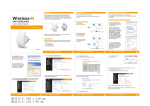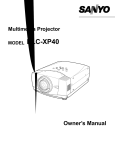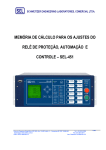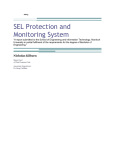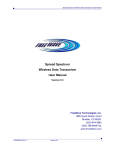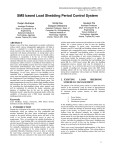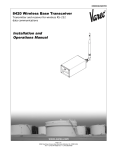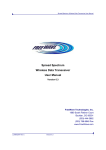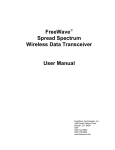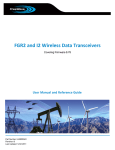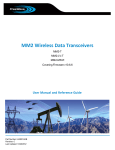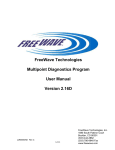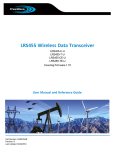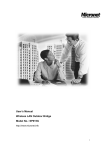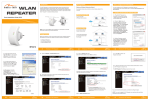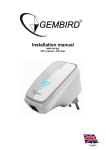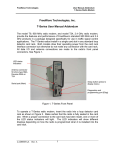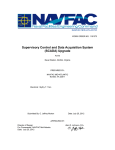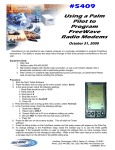Download LAD0006AB Rev A 1 Using the FGR
Transcript
FreeWave Technologies User Manual Addendum FGR-115MB Mirrored Bit Radio Modem Using the FGR-115MB in Mirrored Bit Applications The FreeWave Technologies FGR-115MB Spread Spectrum transceiver is a special version of the FGR-Series product family. It provides additional features that are optimized for use with Schweitzer Engineering Labs Mirrored Bit Communications in high-speed protective relay and other applications. The FGR-115MB is a cost-effective, reliable, and secure alternative to optical fiber, metallic pilot wire and other communications technologies for Mirrored Bit communications. The FGR-115MB contains all of the features and functions of the standard FGRSeries 900 MHz spread spectrum product family and may be used in any other application where the standard products can be used with the exception of applications using either Ethernet or the optional TDMA mode. Ethernet and TDMA are not available on the FGR-115MB. For use in Mirrored Bit applications, specific settings must be made to the FGR115MB as described in this addendum. The three parts of this addendum explain the setup of a point-to-point Mirrored Bit link, the setup of a Mirrored Bit link with one repeater hop, and troubleshooting techniques for mirrored bit links. Refer to the FGR-115RC User Manual for more information on programming the FGR-115MB for applications where Mirrored Bit communication is not used. Part 1. Programming a point-to-point Mirrored Bit Link Connect an ASC0409 DC Programming/Diagnostics cable from the Diagnostics port on the FGR-115MB to the serial port on the programming terminal. Set up the programming terminal as described in the FGR-Series user manual. Invoke the setup menu by pressing the SETUP button on the radio’s rear panel or by sending an uppercase U from the programming terminal. Programming must be done through the Diagnostics port. The programming menu will not be displayed through the radio’s RS-232 port. SETUP button RS-232 port (main) Diagnostics port Figure 1. FGR-115MB rear panel LAD0006AB Rev A 1 FreeWave Technologies User Manual Addendum FGR-115MB Mirrored Bit Radio Modem The radio’s main menu will be displayed as shown in Figure 2 below. The three LEDs on the radio’s front panel will be green. When the radio is in setup mode, the radio link is disconnected and data will not pass through the link. Figure 2. Main Menu 1.1 Set Operation Mode Enter a 0 (zero) to open the Set Operation Mode menu. The menu will be displayed as shown in Figure 3 below. A point-to-point Mirrored Bit communication link requires two radios. One radio must be set to be the Mirrorbit Master (an entry of A in the Operation Mode menu). The other radio must be the Mirrorbit Slave (an entry of B). Although the entry is made as either an A or B, the Modem Mode indication at the top of the menu page will be 10 for Mirrorbit Master or 11 for Mirrorbit Slave. When the entry has been made, press ESC to return to the main menu. LAD0006AB Rev A 2 FreeWave Technologies User Manual Addendum FGR-115MB Mirrored Bit Radio Modem Figure 3. Operation Mode Menu Select A or B 1.2 Set Baud Rate Enter 1 from the Main Menu to open the Set Baud Rate menu. The menu will be displayed as shown in Figure 4 below. For Mirrored Bit operation, the Baud Rate on each radio must be set to either 9,600 or 38,400 (entry 4 or 6 in the Baud Rate menu). These are the only baud rate selections that are valid for Mirrored Bit operation. Each radio must be set to match the baud rate of the Mirrored Bit device to which it is connected and both radios must be set to the same baud rate. For optimum Mirrored Bit performance, a baud rate of 38,400 is recommended. The Setup Port must be set to 2 (Diag only). To change the Setup Port, select Setup Port (menu item D). The Setup Port menu will be displayed as shown in Figure 5 below. Enter 2 (For Diag Only) as shown. When the baud rate and Setup Port entries have been made, press ESC to return to the main menu. LAD0006AB Rev A 3 FreeWave Technologies User Manual Addendum FGR-115MB Mirrored Bit Radio Modem Figure 4. Baud Rate Menu Select 9,600 or 38,400 Figure 5. Setup Port Menu Change Setup Port to Diag only LAD0006AB Rev A 4 FreeWave Technologies User Manual Addendum FGR-115MB Mirrored Bit Radio Modem 1.3 Edit Call Book Enter 2 from the Main Menu to open the Edit Call Book menu. When using a pair of FGR-115MB radios in a Mirrored Bit application, each radio must have the other radio's serial number as the first entry in its Call Book with no entries in the Repeater1 and Repeater2 columns as shown in Figure 6 below. In addition, the Mirror Bit Master must be programmed to call the first entry in its Call Book. To make a call book entry, enter a 0 (zero) and, at the prompt, enter the sevendigit serial number of the other radio in the link. Do not enter the dash character. At the Enter Repeater1 prompt, press ESC to complete the entry. Do not use the Repeater1 and Repeater2 prompts to enter repeater serial numbers. Refer to Part 2 of this addendum for instructions on programming Mirrored Bit repeaters. The Mirrored Bit Slave will not establish communication with the master by turning Slave Security off. The Slave must have the Mirrored Bit Master's serial number as the first entry in its call book. Figure 6. Edit Call Book Menu When the call book entry is complete, press ESC to return to the main menu. LAD0006AB Rev A 5 FreeWave Technologies User Manual Addendum FGR-115MB Mirrored Bit Radio Modem 1.4 Edit Radio Transmission Characteristics From the Main Menu, enter 3 to open the Edit Radio Transmission Characteristics Menu as shown in Figure 7 below. All values in the Radio Parameters menu must be identical for the Mirrored Bit master and the Mirrored Bit slave radios with the exception of RF Xmit Power (menu item 5) and High Noise (menu item A). For more information on these functions refer to the FreeWave FGR-Series User Manual. MCU Speed (menu item B) must be set to 1. If more than one pair of FreeWave 900MHz transceivers are operating in close proximity they must be set to different Frequency Keys (menu item 0). This is also necessary if the radios are to be configured as a Mirrored Bit repeater. Refer to Part 2 of this addendum for instructions on programming a Mirrored Bit repeater. Unlike the DGR-Series Mirrored Bit radios, it is not necessary to change Hop Table Size on the FGR-115MB for Mirrored Bit operation. Hop Table Size should be left at its standard setting of 112. Figure 7. Radio Transmission Characteristics Menu Use different FreqKey settings to avoid interference. Master and Slave must be set to the same value. Set MCU Speed to 1 When the radio parameters entries are complete, press ESC to return to the main menu. 1.5 Edit MultiPoint Parameters From the Main Menu, enter 5 to open the Edit MultiPoint Parameters Menu as shown in Figure 8 below. For Mirrored Bit operation without a repeater, 1 PPS LAD0006AB Rev A 6 FreeWave Technologies User Manual Addendum FGR-115MB Mirrored Bit Radio Modem Enable/Delay must be set to 255. If 1 PPS Enable/Delay is set to any other value, change it to 255. Press ESC to return to the main menu. Figure 8. Edit MultiPoint Parameters Menu Set 1 PPS Enable/Delay to 255 Press ESC again to exit the setup menu and return the FGR-115MB to operation mode. The Mirrored Bit link is now ready to transmit Mirrored Bit data. Connect the antenna connector on each radio to its antenna system. Connect the comm. Port on each radio to its Mirrored Bit device using a straight through RS-232 cable. (An RS-232 gender changer may be required to connect the RS-232 cable to the Mirrored Bit device.) Refer to Part 3, troubleshooting, if the link does not function properly. Figure 9 shows a typical Mirrored Bit installation between an SEL 351R and 351S using FGR-115MB radios. Many other configurations are possible. LAD0006AB Rev A 7 FreeWave Technologies User Manual Addendum FGR-115MB Mirrored Bit Radio Modem Figure 9. Typical Mirrored Bits Installation LAD0006AB Rev A 8 FreeWave Technologies User Manual Addendum FGR-115MB Mirrored Bit Radio Modem Typical Equipment List The following equipment list details the typical components and connections for each end of a Mirrored Bit link, as shown in Figure 9 above. A pole, tower, or other means of elevating the antenna is not shown. SEL relays or other Mirrored Bit devices are not included. Typical Equipment List Qty Item Description 2 900 MHz SpreadSpectrum Transceiver FreeWave Technologies, Inc. Model FGR115MB. 6 to 30 volt dc power, 1 W output, 20+ miles line-of-sight, 120 Vac-to-12 Vdc adapter, 6’ DB-9M-to-DB-9F straight-through cable and DB-9 male-to-male gender changer included. (An SEL C285 cable can be used directly without adaptors if desired.) 2 Yagi Antenna FreeWave Technologies, Inc. 1 Model EAN0900YC. 10 dB, directional, 26” long. $195 2 Low-Loss RF Cable FreeWave Technologies, Inc. 2 Model ASC1004NN. 100’ length $185 2 Fiber-Optic Transceiver SEL 3 Model SEL-2800M. EIA-232 DB-9M-to-Fiber-Optic Transceiver. $102 1 Fiber-Optic Cable SEL 3 Model C800FZ. Terminated Cable, 25’ or less (other lengths available) $60 1 DB-9 Null Modem Adapter FreeWave Technologies, Inc Model ECD0009NM 9 pin male to 9 pin female Null Modem Adapter, or equivalent (one end is male, one end is female) $7 2 Surge Protection Northern Technologies, Model QWS-920N 4. N Type M-to-F ¼ shorting stub coaxial protector tuned for 870 - 970 MHz. www.northern-tech.com (800) 727-9119 $135 LAD0006AB Rev A 9 Approx. Cost $1,350 FreeWave Technologies User Manual Addendum FGR-115MB Mirrored Bit Radio Modem Notes: 1. Other antennas are available. 2. Other RF cable lengths are available. 3. Other fiber-optic transceivers and cable may be used. Note, the fiber-optic transceivers are not required, but provide complete isolation between the radio and antenna and the relay. 4. Other surge protection may be used (PolyPhaser, etc.). FreeWave recommends northern Technologies for use with their radios. Other Notes 1. In Mirrored Bits mode, the FGR-115MB may be used with a number of different SEL devices, please contact SEL at www.selinc.com for a complete list of supported devices. 2. When the FGR-115MB is used for Mirrored Bits communication, one repeater may be used in the link. Refer to Programming A Mirrored Bits repeater in this addendum for more information. 3. When the FGR-115MB is used for Mirrored Bits communication, it is not compatible with the models DGR-115RU or DGR-115RXU Mirrored Bit radios if these radios are also being used for Mirrored Bits communications. Otherwise, the FGR-115MB is compatible with any DGR or FGR-Series radios when used in standard point-to-point or point-to-multipoint modes. Part 2. Programming a Mirrored Bit Repeater Unlike a standard FreeWave point-to-point or point-to-multipoint repeater, which requires only one radio, a Mirrored Bit repeater uses two radios in a “back-toback” configuration. One of these radios is a Mirrored Bit slave and the other radio is a Mirrored Bit master. Each of these radios communicates with another radio at another location in a point-to-point Mirrored Bit link. The master at the repeater site communicates with a remote Mirrored Bit slave radio. The slave at the repeater site communicates with a remote Mirrored Bit master radio. Follow the instructions in Part 1 of this addendum to first set up each of the separate Mirrored Bit links. Set each of the separate Mirrored Bit links on a different frequency key to minimize interference at the repeater site. Follow the instructions in Part 2 only for the radios to be installed at the repeater site. LAD0006AB Rev A 10 FreeWave Technologies User Manual Addendum FGR-115MB Mirrored Bit Radio Modem 2.1 Set Baud Rate Enter 1 from the Main Menu to open the Set Baud Rate menu as shown in Figure 10 below. For Mirrored Bit repeater operation, the Baud Rate on each radio in the repeater pair must be set to 230,400 (entry 0 (zero) in the Baud Rate menu). This is the only baud rate selection that is valid for Mirrored Bit repeater operation. Do not change the baud rate settings of the other radios that will be linked to the master and slave radios at the repeater site. These radios must be set to match the baud rate of the Mirrored Bit devices to which they are connected and both of these radios must be set to the same baud rate. When the baud rate entry has been made, press ESC to return to the main menu. Figure 10. Set Baud Rate Menu Set to 230,400 2.2 Edit Multipoint Parameters Enter 5 from the Main Menu to open the Edit Multipoint Parameters menu as shown in Figure 11 below. For Mirrored Bit repeater operation 1 PPS Enable/Delay (Menu Item 9) must be changed from its normal setting of 255 to a new setting of 0. Do not change the 1 PPS Enable/Delay settings of the other radios that will be linked to the master and slave radios at the repeater site. LAD0006AB Rev A 11 FreeWave Technologies User Manual Addendum FGR-115MB Mirrored Bit Radio Modem Figure 11. Edit MultiPoint Parameters Menu Set to 0 When 1 PPS Enable/Delay has been set to 0, press ESC to return to the Main Menu. Press ESC again to exit the setup menu and return the radio to operation mode. Connect the data ports on the master and slave radios at the repeater site with an RS-232 null modem cable. Connect both radios to their separate antenna systems. The radios are now ready to function as a Mirrored Bit repeater. See Figure 12 below. If Mirrored Bit communications cannot be established through the repeater, refer to Part 3, troubleshooting, at the end of this addendum. LAD0006AB Rev A 12 FreeWave Technologies User Manual Addendum FGR-115MB Mirrored Bit Radio Modem Figure 12. Mirrored Bit Repeater Configuration Antenna 20 Miles, Line-of-Sight Antenna Freewave FGR-115MB Transceiver (slave 1) M-to-M Null Modem Adapter FreeWave FGR-115MB Transceiver (master 1) DB-9M–DB-9F Straight-Through Cable DB-9M–DB-9F Straight-Through Cable Freewave FGR-115MB Transceiver (master 2) M-to-F Straight-Through Adapter SEL-351S-7 Relay (RXID=1, TXID=2) 20 Miles, Line-of-Sight Antenna Antenna FreeWave FGR-115MB Transceiver (slave 2) DB-9M–DB-9F Straight-Through Cable M-to-F Straight-Through Adapter SEL-351S-7 Relay (RXID=1, TXID=2) LAD0006AB Rev A 13 FreeWave Technologies User Manual Addendum FGR-115MB Mirrored Bit Radio Modem Typical Equipment List for Mirrored Bit Repeater Qty Item Description Approx. Cost 2 900 MHz SpreadSpectrum Transceiver FreeWave Technologies, Inc. Model FGR-115MB. 6 to 30 volt dc power, 1 W output, 20+ miles line-ofsight, 120 Vac-to-12 Vdc adapter, 6’ DB-9M-to-DB9F straight-through cable and DB-9 male-to-male gender changer included. (An SEL C285 cable can be used directly without adaptors if desired.) $1,350 2 Yagi Antenna FreeWave Technologies, Inc. 1 Model EAN0900YC. 10 dB, directional, 26” long. $195 2 Low-Loss RF Cable FreeWave Technologies, Inc. 2 Model ASC1004NN. 100’ length $185 1 DB-9 Null Modem Adapter FreeWave Technologies, Inc Model ECD0009NM 9 pin male to 9 pin female Null Modem Adapter, or equivalent (one end is male, one end is female) $7 2 Surge Protection Northern Technologies, Model QWS-920N 4. N Type M-to-F ¼ shorting stub coaxial protector tuned for 870 - 970 MHz. www.northern-tech.com (800) 727-9119 Notes: 1. Other antennas are available. 2. Other RF cable lengths are available. 3. Other surge protection may be used (PolyPhaser, etc.). FreeWave recommends northern Technologies for use with their radios. Part 3. Troubleshooting The front panel LEDs are very useful in quickly determining the current condition of the FGR-115MB. The table below shows the most common conditions. Condition CD Powered and connected SG LAD0006AB Rev A Master TR CTS SR SR 14 CD SG Slave TR CTS SR SR $135 FreeWave Technologies User Manual Addendum FGR-115MB Mirrored Bit Radio Modem Powered and connected, weak link Powered, disconnected Powered and connected but on different Freq Keys Setup Mode SG SR IF SG SR IF SR SR SR SR O BR SG/ SR (altern ating) SG SR (on and off) SG IF SG IF SR SG SG SG SG Legend: BR IF O SG SR Blinking Red Intermittent Flash Red Off Solid Green Solid Red, Bright Symptom Radio is not linked, CD LED is red. Possible Cause Radio on other end of link is not powered Radio on other end of link in setup mode Incorrect programming Obstructions blocking signal path Excessive interference Excessive interference Radio is linked but no communications between Mirrored Bit devices Incorrect baud rate or comm. Port settings Radio connected to wrong port on Mirrored Bit device LAD0006AB Rev A 15 Solution Apply power to other radio Check that other radio is not in setup mode. Recheck programming Relocate antennas to provide clearer radio path or consider using a repeater. Turn on High Noise feature in Radio Parameters Menu. Install EBF900 bandpass filter Recheck that baud rate settings on Mirrored Bit devices match baud rate setting on radios. Verify that Mirrored Bit devices are set to 9600 or 38400 bps and MB8A protocol. Make sure that radios are connected to correct port on Mirrored Bit device. FreeWave Technologies User Manual Addendum FGR-115MB Mirrored Bit Radio Modem Incorrect serial cable connection Mirrored Bit communications log shows numerous errors If repeater is used, cable connection between repeater radios is incorrect Local noise and interference Unavailability log is less than .001. See Figure 13 below Excessive local interference, Unavailability log shows more than .001. LAD0006AB Rev A 16 Check that radios are connected to Mirrored Bit devices with straight through RS-232 cable. If fiber optic transceiver is used, make sure that null modem adapter is used between radio and transceiver. Connect serial ports on radios at repeater site with null modem cable. Check Unavailability Mirrored Bit device comm. Log. Noise and interference will cause numerous short-term errors but will not affect reliability of communications. Typical outage will last less than 10 ms. Unavailability will be less than .001. Check radio performance with point-to-point diagnostics program. Use High Noise feature or EBF900 filter or both. Check for noise sources in area. FreeWave Technologies User Manual Addendum FGR-115MB Mirrored Bit Radio Modem Failure log shows outages lasting longer than 50 ms LAD0006AB Rev A 17 Check radio performance with point-to-point diagnostics program. Use High Noise feature or EBF900 filter or both. Check for noise sources in area. Relocate antennas to reduce interference or to increase signal strength. Change antenna polarization. Make sure distance between sites does not exceed maximum operating range of radios. Consider using a repeater. FreeWave Technologies User Manual Addendum FGR-115MB Mirrored Bit Radio Modem Figure 13. SEL Communications Log. Point-to-Point Diagnostics The FreeWave Point-to-Point Diagnostics Program allows continuous monitoring of the performance of a Mirrored Bit link without disrupting the operation of the link. The program is included on the CD-ROM containing the FGR-115MB user manual and this addendum. The program may be run on either the Mirror Bit master or the Mirror Bit slave radio. Locate the diagnostics program on the disk file and open the program. Connect the ASC0409DC Programming/Diagnostics cable between the Diag port of the FGR-115MB and the Comm Port on the computer. Select the Communication menu and click Open Comm if the comm. Port to be used is Comm 1. Otherwise, click on Chg Comm port to select a comm. Port other than Comm 1. LAD0006AB Rev A 18 FreeWave Technologies LAD0006AB Rev A User Manual Addendum FGR-115MB Mirrored Bit Radio Modem 19 FreeWave Technologies User Manual Addendum FGR-115MB Mirrored Bit Radio Modem To change the comm. Port select Chg Comm port. To start the program, select Open Comm. LAD0006AB Rev A 20 FreeWave Technologies User Manual Addendum FGR-115MB Mirrored Bit Radio Modem Select any comm. Port from 1 to 8. The diagnostics program displays three screens of information. Navigation to each screen is done by entering the number of the screen, 1, 2, or 3. Diagnostics Screen 1 Screen 1 displays real-time graphs of antenna reflected power (VSWR) versus frequency (green line) and transmit current versus frequency (red line). A reflected power indication of 20 or higher indicates a possibly defective antenna system. The transmit current will vary with the radio’s dc supply voltage. Typical values are 350 ma at 6 volts dc, 175 ma at 12 volts dc and 90 ma at 24 volts dc. The dip in the middle of the graph represents frequencies on which data is not transmitted. For this reason, the displayed values at these frequencies are always displayed as zero and should be ignored. LAD0006AB Rev A 21 FreeWave Technologies User Manual Addendum FGR-115MB Mirrored Bit Radio Modem Diagnostics Screen 1 Diagnostics Screen 2 Screen 2 displays real-time graphs of percent receive rate versus frequency (blue line), received signal level versus frequency (green line), noise level versus frequency (red line) and peak noise level versus frequency (yellow line). For reliable Mirrored Bit operation, an average receive rate of 80% or higher is recommended. The receive rate is effected by received signal strength and by noise and interference. The average signal level indicates how well that this radio hears the radio on the other end of the link. The values displayed are – dBm. A displayed value of 100 is higher than a value of 110. The program does not display the minus sign. For reliable Mirrored Bit operation, a level of 90 or higher is recommended. The noise level is also displayed in –dBm. For reliable Mirrored Bit operation, a noise level at least 20 below the average signal level is recommended. LAD0006AB Rev A 22 FreeWave Technologies User Manual Addendum FGR-115MB Mirrored Bit Radio Modem The peak noise trace captures and holds the transient noise that is detected by the radio. This provides an indication of interference sources in the area even if the interference is not steady state. Diagnostics Screen 2 Diagnostics Screen 3 Screen 3 of the diagnostics program provides a continuous plot of radio link performance versus time. The time scale begins when the diagnostics program is started (time 0) and automatically rescales as the program runs with the most recent data on the left end of the plot. Error % (blue line) records the percentage of bad packets that were received and discarded. This is the inverse of the percent good shown in screen 2. Signal Lv, (green line) is the received signal strength in –dBm. Noise Lv, (red line) is the noise level at the radio’s input in -dBm. Xmit Rate, (brown line) is the transmitted data transfer speed in kB/sec. Rcvd Rate, (orange line) is the received data transfer speed in kB/sec. LAD0006AB Rev A 23 FreeWave Technologies User Manual Addendum FGR-115MB Mirrored Bit Radio Modem Diagnostics Screen 3 Contacting FreeWave FreeWave Technologies 1880 S. Flatiron Ct. Boulder, CO 80301 Phone: (800) 548-5616 Fax: (303) 786-9948 www.freewave.com Technical Support Center hours 8 AM to 5 PM Mountain Time Monday through Friday. LAD0006AB Rev A 24
























